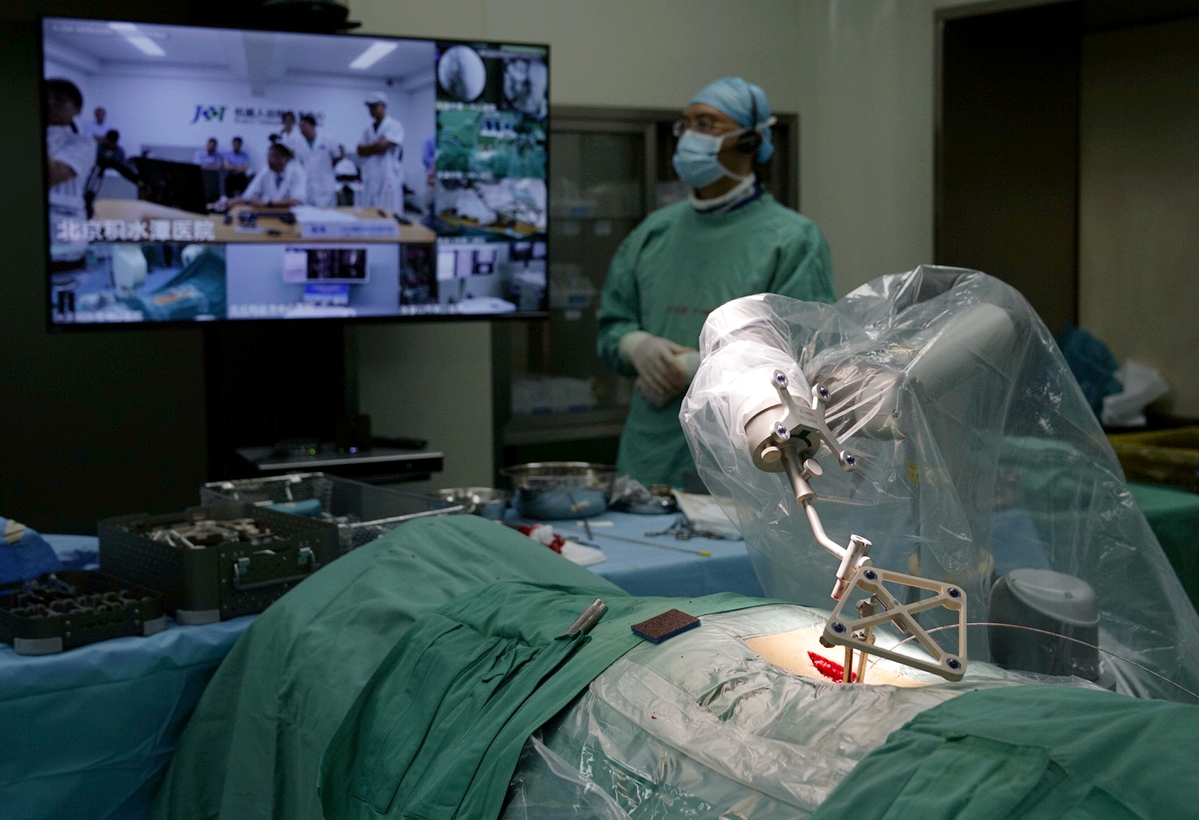5G URLLC
Ericsson on 5G use cases: remote surgery, augmented and virtual reality with AI agent all depend on 3GPP URLLC specs
5G for Remote Surgery:
This year, surgeons in Florida working with Ericsson, were able to operate on remote patients in Dubai and Shanghai, using 5G technology, according to Mischa Dohler, Ericsson vice president-emerging technologies.
A hospital in China used a 5G-enabled robot to perform spinal surgery on patients, and doctors used VR headsets to livestream the operation. The robot implanted over 62 pedicle screws in the patients’ spinal cord. Here’s a pic of that:

Photo by Wang Fei/For China Daily
Dohler said he’s working with the White House, FCC, NTIA, Food and Drug Administration and others to make remote surgery “a reality.” More widespread use of the technology won’t happen unless smaller carriers also get involved. We will have not only humans using your networks, but also machines more and more,” Dohler added.
Gartner’s market research underscores the importance of 5G SA, predicting that by 2025, it will be the foundation for the majority of applications demanding sub-10 millisecond latency. This transition is not merely a technical upgrade but a strategic enabler for industries poised to benefit from real-time data processing and decision-making. However, the ultra low latency depends on two 3GPP Release 16 specs – 1.] 5GNR enhancements for URLLC in the RAN and 2.]URLLC in the 5G SA core network– being completed, performance tested and implemented. That has not happened yet and without it there can’t be any 5G URLLC use cases like remote surgery!
Real-time remote surgeries, once a concept of futuristic medicine, are becoming a reality. The ability to perform surgical procedures from thousands of miles away, with real-time response and precision, could revolutionize healthcare accessibility and outcomes. For example, a pilot project involving 5G SA-enabled remote surgery successfully demonstrated how surgeons could operate with millisecond-level precision, mitigating geographical barriers to specialized medical care.
……………………………………………………………………………………………………………….
Ericsson’s Dohler predicted growing use of augmented and virtual reality and AI “agents,” computer programs capable of performing tasks autonomously, which people will use as part of their daily lives. New technology will require networks that can handle increased traffic, he said. New data traffic patterns “will hit you at some point this decade,” he said. “You will need to do some bold moves.”
………………………………………………………………………………………………………..
References:
https://www.ericsson.com/en/blog/2024/3/cutting-the-cord-lifesaving-telesurgery-in-the-age-of-5g
https://www.chinadaily.com.cn/a/201908/29/WS5d670e17a310cf3e355686fa.html
https://www.linkedin.com/pulse/dawn-new-era-navigating-shift-from-5g-nsa-sa-tayroni-fkvre/
3GPP Release 16 5G NR Enhancements for URLLC in the RAN & URLLC in the 5G Core network
Introduction:
3GPP Release 16 was “frozen” July 3, 2022. However, two key work items were not completed: Enhancement of the 5G RAN and the 5G Core network to support ultra-high reliability and low-latency communications (URLLC).
The enhancements, especially in the RAN, are essential for 3GPP New Radio (NR) to meet the ITU-R M.2410 Minimum Performance Requirements for the URLLC use case. That was to enable a whole new set of mission critical applications that required either ultra high reliability or ultra low latency (< or =1 ms in the data plane and < or =10ms in the control plane) or both.
Yet URLLC in the RAN and the associated URLLC in the RAN Conformance Test specification still have not been completed (see below)!
Overview of URLCC Enhancements:
The main functionalities introduced were the support of redundant transmission, QoS monitoring, dynamic division of the Packet Delay Budget, and enhancements of the session continuity mechanism.
The 3GPP Rel 16 URLLC in the RAN spec, once complete and performance tested, is needed to meet the ITU-R M.2410 URLLC Performance Requirements.
The 5G NR Physical Layer is improved for the support of URLLC in the RAN in several ways: new DCI formats, Enhanced PDCCH monitoring capability, Sub-slot based HARQ-ACK feedback, Two HARQ-ACK codebooks constructed simultaneously, PUSCH enhancements, Enhanced inter UE Tx prioritization/multiplexing and Multiple active configured grant configurations for a BWP.
Current Status:
The most recent URLLC in the RAN spec dated December 2022 is 96% complete as per:
| 830074 | NR_L1enh_URLLC | Physical Layer Enhancements for NR Ultra-Reliable and Low Latency Communication (URLLC) | Rel-16 | R1 | 22/12/2022 | RP-191584 | history | 2019/03/26 | 26/06/2019 | 26/6/19: WID:RP-190726->RP-191584 |
The URLLC in the RAN Conformance Test spec is only 90% complete as per:
| 900054 | NR_L1enh_URLLC-UEConTest | … UE Conformance Test Aspects – Physical Layer Enhancements for NR URLLC | Rel-16 | R5 | 22/12/2022 | RP-202566 | history | 2021/01/06 | 20/06/2022 | 22/3/22: Compl:16 ; 20/6/22: Rapporteur: Huawei->Chunying GU, Huawei; Rap eMail: ->guchunying@huawei. |
……………………………………………………………………………………………………..
Here are the key 3GPP Rel16 URLLC work items from https://www.3gpp.org/dynareport?code=WI-List.htm
- 830074 NR_L1enh_URLLC Physical Layer Enhancements for NR Ultra-Reliable and Low Latency Communication (URLLC)
- 800095 FS_NR_L1enh_URLLC… Study on physical layer enhancements for NR UR Low Latency Cases
- 830174 NR_L1enh_URLLC-Core… Core part: Physical Layer Enhancements for NR URLLC
- 830274 NR_L1enh_URLLC-Perf… Perf. part: Physical Layer Enhancements for NR URLLC (R4)
- 900054 NR_L1enh_URLLC-UEConTest… UE Conformance Test Aspects – Physical Layer Enhancements for NR URLLC (R5)
References:
https://www.3gpp.org/dynareport?code=WI-List.htm
https://www.3gpp.org/dynareport?code=status-report.htm
https://www.3gpp.org/dynareport?code=FeatureOrStudyItemFile-830074.htm
https://www.3gpp.org/technologies/urlcc-2022
https://techblog.comsoc.org/category/3gpp-release-16
Executive Summary: IMT-2020.SPECS defined, submission status, and 3GPP’s RIT submissions
5G Specifications (3GPP), 5G Radio Standard (IMT 2020) and Standard Essential Patents
Another Opinion: 5G Fails to Deliver on Promises and Potential


